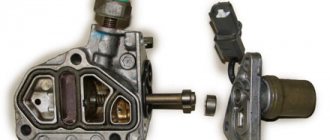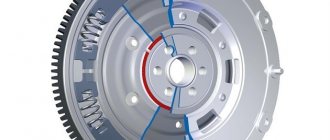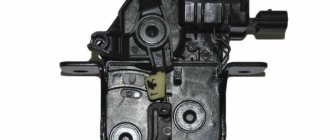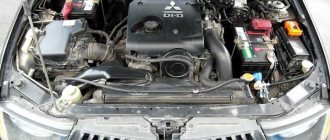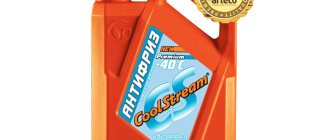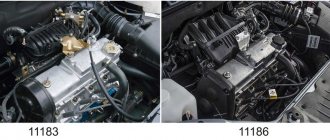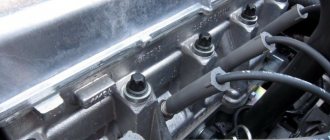The front-wheel drive small car Lada Granta has been produced by AvtoVAZ since December 2011. The Lada Granta is powered by engines that were previously equipped with cars of the Kalina model range. The Lada Granta engine, which is most often equipped with the “Norma” and “Lux” versions, is the VAZ-11186, which is part of the well-known line of VAZ engines 21083/21114/21116/21124/11183/11186/11189.
16 valve engine
This is a more technically advanced brother of the 8-valve. In fact, it represents a deep modernization of the VAZ-21126 engine. The model received an intake receiver of variable length, due to which its power increased from 98 hp. up to 106 hp
Advantages of a 16-valve engine
If you tune the version with 16 valves, you can reduce the acceleration time of the car to 9 seconds. This is ideal for highways where speeds exceed 100 km/h. At these speeds, the 16-valve model feels more confident in handling.
The design of the internal combustion engine includes hydraulic compensators, which save the machine from zero maintenance with valve adjustment. There is a groove in the engine, so there is no need to be afraid that the valves will be bent.
Disadvantages of the 16-valve engine:
- cost - in some versions of the Lada Granta, the price difference between models with 8 and 16 valves is 100,000 rubles.
In terms of torque, the 16-valve version is inferior to the 8-valve version. To spin the engine to 148 N*m, you will need more than 4000 rpm.
Among the design flaws, it is worth mentioning the problem of spark plug wells sweating with a mileage of 10,000 km or more. Oil begins to drip inside. This is due to the use of sealant rather than gasket as a seal.
Differences between series 21116 and 11186
One of the most popular engines is the 21116 series unit. The domestic manufacturer produces cars with this engine under the hood. It is provided for the standard Lada Granta configuration.
This engine has an imported piston system designed for any kind of firmware. A huge disadvantage of this unit is that when the timing belt breaks, the valves automatically bend. The power of the 116th engine according to documents is 90 hp. pp., in reality, drivers achieve higher rates.
The difference between this type of internal combustion engine and the 11186 series engine is that the latter is derated by 3 hp. With. to reduce detonation. The second no less important distinctive feature of the 11186 engine is that its piston system is a domestic product. The 11186 series internal combustion engine has been developed in accordance with the international environmental standard EURO-4 for the regulation of harmful substances in exhaust gases. Usually people prefer to do chip tuning to strengthen these engines.
Manufacturers called the 21116 engine series an upgrade of the previous 114 series. The changes affected only the installation of a lightweight connecting rod-piston system. One of the features of a breakdown is that the pistons break into several parts. This is due to the fact that the new pistons are lighter and thinner; when they encounter valves, they break. Connecting rods often break as well. The total cost of repairs in such cases can reach or even exceed half the cost of a Lada Grant engine.
However, lovers of maneuverability in driving will like this engine more than 21114. It is 6 hp stronger. With. and is much quieter. As a result, additional chip tuning and noise insulation may not be required. It all depends on the wishes of the driver.
New 8-valve VAZ-11182
In 2022, AvtoVAZ introduced a new engine for the Lada Granta FL. This is AR16SEg2 or VAZ-11182. Its main feature is an increase in torque. At 1000 rpm, 80% of the torque is already available.
Design changes include:
- renewal of the connecting rod and piston group;
- modernization of the gas distribution mechanism;
- crankshaft modernization.
Advantages of VAZ-11182:
- reduced consumption;
- reduction in switching frequency;
- no need to adjust valves up to 90,000 km;
- groove;
- absence of oil drips due to six-bolt fastening of the oil cap and improved design of the silicone gasket;
- use of Renault spare parts;
- resource 180,000 km.
Disadvantages of the VAZ-11182:
- lack of hydraulic compensators;
- complicated valve clearance adjustment (at a mileage of 90,000 km);
- increased compression ratio, for better torque you will need to fill in AI-95;
- high cost of spare parts.
Motor series 21114
The 114th Lada Granta engine is available for standard equipment; some drivers update its electronic control unit. Chip tuners and diagnosticians calibrate the engine and sometimes change the program code. After well-performed 30 to 1000 calibrations, the car becomes more maneuverable and the engine runs smoother.
The torque and power of the motor also increase. Fuel consumption is sharply reduced. There are many advantages, but there is only one drawback: it is better not to do excessively frequent calibrations (as well as tuning performed by a non-professional) - this can lead to a deterioration in all of the above indicators.
This engine came from the Lada Kalina. Its volume is 1.6 liters, and it has 8 valves. Although its power is small, it is the most torquey of all domestic engines. People experience virtually no discomfort while driving. In this case, before doing chip tuning, you should decide what is more important: speed and fuel consumption or a comfortable ride.
Another big advantage of this engine is the reliability of the gas distribution mechanism.
Often, if the timing belt breaks, it can be replaced on the road without problems and continue the trip to the nearest inspection station . This is due to the fact that in this engine the valves do not collide with the pistons and, accordingly, do not bend. This means that the operation of the engine itself is practically undisturbed. In addition, it is very easy to maintain due to the fact that its design is identical to the engine from the VAZ 2108 (except for the increased volume). And to increase maneuverability and reduce fuel consumption, some drivers order chip tuning (firmware of the electronic control unit).
Characteristics of power units
| Motor | 8-valveVAZ-11186 | 16-valve VAZ-21127 | 8-valve VAZ-11182 |
| Overclocking | 11.6 s. | 10.5 s. | – |
| Engine power | 87 hp | 106 hp | 90 hp |
| Torque | 3800 rpm 140 N*m | 4000 rpm 148 N*m | 3800 rpm 143 n*m |
| Volume | 1596 cm3 | ||
| Diameter of one cylinder | 82 mm | ||
| Piston stroke | 75.6 mm | ||
| Nutrition | injector | injector | distribution injection |
| Compression | 10.3-10.5 | 10.5-11 | 10.5 |
Lada Granta engines 8 valves
This power unit was installed only until December 2014, until it gave way to the 11186 internal combustion engine. This is an injection 8-valve engine with a single camshaft, a timing belt drive and without hydraulic compensators, so the thermal valve clearances here will have to be adjusted yourself. Thanks to special holes in the pistons, if the valve belt breaks, it will never bend.
There are plenty of problems with this engine; first of all, owners are bothered by all sorts of noises, knocks, and vibrations. Unreliable electrics, as well as a capricious thermostat, can throw you many unpleasant surprises. Due to poor fuel, valve burnout sometimes occurs here.
Sedan before restyling 2011 - 2019
| 1.6 l 11183 MKP5 | |
| Type | injector |
| Fuel | gasoline AI-92 |
| Location | transverse |
| Cylinders | 4 in a row |
| valves | 8 |
| Working volume | 1596 cm³ |
| Power | 82 hp |
| Torque | 132 Nm |
| Acceleration to 100 km/h | 12.6 s |
| Speed (max) | 165 km/h |
| Ecological Class | Euro 4 |
| Consumption city | 9.7 l |
| Flow track | 6.1 l |
| Mixed flow | 7.4 l |
Similarly, the Motor VAZ website talks about all the details of the internal combustion engine design
This unit is an improved version of the previous one. There is already a lightweight piston with anti-friction inserts, a timing belt from Gates with a service life of 180 thousand km, an electronic throttle valve, a developed cooling jacket and many other improvements, thanks to which it was possible to fit this rather old engine into the strict EURO 4 econorms. Due to the new pistons without holes in the bottom, if the valve belt breaks, it almost always bends. Update: in mid-2022, the manufacturer equipped the unit with plugless pistons.
The list of typical malfunctions of this power unit is quite long. Owners of cars with such an engine regularly encounter burnout of valves due to bad gasoline, overheating, oil leaks, failures of various sensors, and also glitches of the E-gas system.
Sedan before restyling 2011 - 2019
| 1.6 l 11186 manual gearbox5 | 1.6 l 11186 automatic transmission4 | |
| Type | injector | injector |
| Fuel | gasoline AI-92 | gasoline AI-92 |
| Location | transverse | transverse |
| Cylinders | 4 in a row | 4 in a row |
| valves | 8 | 8 |
| Working volume | 1596 cm³ | 1596 cm³ |
| Power | 87 hp | 87 hp |
| Torque | 140 Nm | 140 Nm |
| Acceleration to 100 km/h | 12.2 s | 14.2 s |
| Speed (max) | 167 km/h | 160 km/h |
| Ecological Class | Euro 4 | Euro 4 |
| Consumption city | 9.0 l | 10.4 l |
| Flow track | 5.8 l | 6.1 l |
| Mixed flow | 6.6 l | 7.7 l |
Tuning
Initially, the manufacturer builds additional potential into its engines in order to make any changes in future versions. However, the 11186 engine can be upgraded on its own. The following type of tuning is considered standard:
- camshaft - replacement of a standard part with a Nuzhdin 10.93 or Dynamics 108 camshaft;
- cylinder block - boring to 86 - 88 mm (pistons and connecting rods of appropriate sizes will be required);
- intake manifold - zero resistance filter, damper with a diameter of 54 mm, grinding of the internal surfaces of the channels;
- catcollector - replacement with a spider having a 4:2:1 scheme;
- Timing - installation of T-shaped lightweight valves;
- Cylinder head – head milling.
Zero resistance filter
Tuning that adds 30% of power is considered safe (“resource-producing”) for the engine. That is, for 87 hp. With. it will be 29 liters. s., which results in about 115 hp. With. Further tuning becomes dangerous, since the service life will decrease in arithmetic progression. This method is used by athletes, but not by ordinary car enthusiasts.
Thus, the 11186 motor has one significant drawback - it bends the valves. The manufacturer partially corrects the situation through high-life timing belts from Gates. In other respects, the internal combustion engine was superior to its existing counterparts at that time, with the exception of the 21114 engine, which was taken as the basis.
If you have any questions, leave them in the comments below the article. We or our visitors will be happy to answer them
Malfunctions: causes, elimination
Like all internal combustion engines with mechanical adjustment of valve clearances, the 11186 engine requires periodic adjustment of this characteristic. In addition, during operation, characteristic “diseases” of this particular version of the power drive were identified:
| Bend valves | broken timing belt | periodic wear monitoring |
| Ignition system interruptions | failure of the corresponding block | replacing the ignition module |
| Increased oil consumption | wear of the main bearings, stuck piston rings | replacement of consumables |
| Knock | wear of pistons, bearings | replacement of parts |
When repairing piston and crankshaft engines, it is recommended to use original components from the AvtoVAZ manufacturer. Because only he uses special technologies for strengthening structural materials. From third-party companies, the metal may be “raw”; the resource of such consumables cannot be analyzed.
The ignition module cannot be repaired
How much horsepower does the Lada Granta actually have?
Car : Lada Granta. Asks : Racer. Question : How much horsepower does the Lada Granta actually have?
When the Lada Granta began to be produced, the VAZ plant deliberately underestimated the power figures. According to the passport it is one thing, but in reality it is another. For example, instead of 87 horsepower, the engines in Norma develop 94. But someone says 98, and all measurements were carried out on a bench. At the same time, the engine itself is not twisted, the ECU is not changed, and everything works as if it came from the factory. Now, please, announce the entire list for each of the 5 engines. Or is it a secret?
Which modern VAZ engine is better to choose for a LADA car?
When choosing a future car, we definitely pay attention to what kind of power unit (heart) it has. Not only the dynamics depend on the motor, but also how much money is required for its maintenance. Do you know which modern VAZ engine to choose?
Let's look at a table with the characteristics of all engines that the manufacturer installs on modern Lada cars (Granta, Kalina, Priora, Largus, Niva, Vesta and XRAY):
| VAZ 21213, 21214 | VAZ 11183 | VAZ 11186, 11189 | VAZ 11182 | VAZ 21126 | VAZ 21127 | VAZ 21126-77 | VAZ 21129 | VAZ 21179 | VAZ 21179-77 | |
| Installed on the car | Lada 4x4, Niva Chevrolet | Granta, Kalina | Granta, Kalina, Largus | Largus, Granta | Granta, Kalina, Priora | Granta and Kalina sport | Vesta, XRAY, Largus | Vesta sport | ||
| Years of production, year | since 1994 | since 2004 | since 2011 | from 2021 | since 2007 | since 2013 | since 2015 | since 2016 | since 2018 | |
| Cylinder block material | cast iron | |||||||||
| Supply system | carb/eng | injector | ||||||||
| Type | in-line | |||||||||
| Number of cylinders | 4 | |||||||||
| Valves per cylinder | 2 | 4 | ||||||||
| Compression ratio | 9,3 | 9,8 | 10,3 | — | 10,45 | 10,3 | 10,7 | |||
| Engine volume, l | 1,7 | 1,6 | 1,8 | 1,8 | ||||||
| Power, hp/rpm | 81/5200 | 82/5100 | 87/5100 | 90/5000 | 98/5600 | 106/5800 | 120/5900 | 106/5800 | 122 | 145 |
| Torque, Nm/rpm | 125/3000 | 132/3800 | 140/3800 | 143/3800 | 145/4000 | 148/4200 | 154/4740 | 148/4200 | ||
| Fuel consumption in the combined cycle, l per 100 km | 10,5 | 7,4 | 7 | 7,5 | 6.8M/7.6A | 6,8 | 7,8 | 6,8 | 7.1 | 7,9 |
| Engine life (according to the passport/actually), thousand km | 80/150 | 150/250 | 200/- | — | 200/200 | 200/200 | 200/200 | — | — | — |
| Transmission | Manual transmission | Manual transmission | Manual transmission | Manual transmission | Manual transmission, automatic transmission | Manual transmission, AMT | Manual transmission | Manual transmission, AMT | Manual transmission, AMT | Manual transmission |
So which engine is better for a modern Lada car? There is no definite answer, but there are a number of parameters by which one or another power unit can be distinguished from others:
Previously conducted surveys on Lada.online and Kolesa.ru:
By the way, we have already talked about modern VAZ engines from a different perspective in this review.
Where can I buy
: in our online store (category 4x4 engines). Prices for other motors on request.
Source
Advantages and disadvantages
The main advantage of the motor is the fact that the manufacturer has already managed to increase the power to 64.2 kW. In addition, it is possible to boost the motor without loss of service life. That is, the owner will not have to make major repairs more often than scheduled.
The disadvantages of ICE 11186 are:
- “meeting” of the piston with the valve in the event of a break in the timing belt drive;
- periodic valve adjustment;
- non-repairable ignition unit.
Adjustment of valves
The advantages of the engine in comparison with the existing versions of the internal combustion engine of the AvtoVAZ manufacturer at the time of its creation are:
- do-it-yourself overhaul after the piston group has reached the end of its service life at least 3 times using different repair kits;
- increased volumes of combustion chambers;
- built-in piston cooling system;
- the hinged one is secured with brackets and has automatic tensioners;
- modernization of the cylinder head and crankshaft;
- piston and crankshaft relief;
- use of parts from existing engines.
Therefore, during repairs and tuning there are no problems with spare parts and components. Maintenance is cheaper than foreign-made engines.
Engine VAZ 11186
The 1.6-liter 8-valve VAZ 11186 engine was first introduced by the company in 2011 and is essentially a modernization of the VAZ 11183 engine, differing from it in having a piston engine. A similar power unit, assembled in another AvtoVAZ workshop, had its own index 21116.
The VAZ 8V line also includes internal combustion engines: 11182, 11183, 11189, 21114 and 21116.

